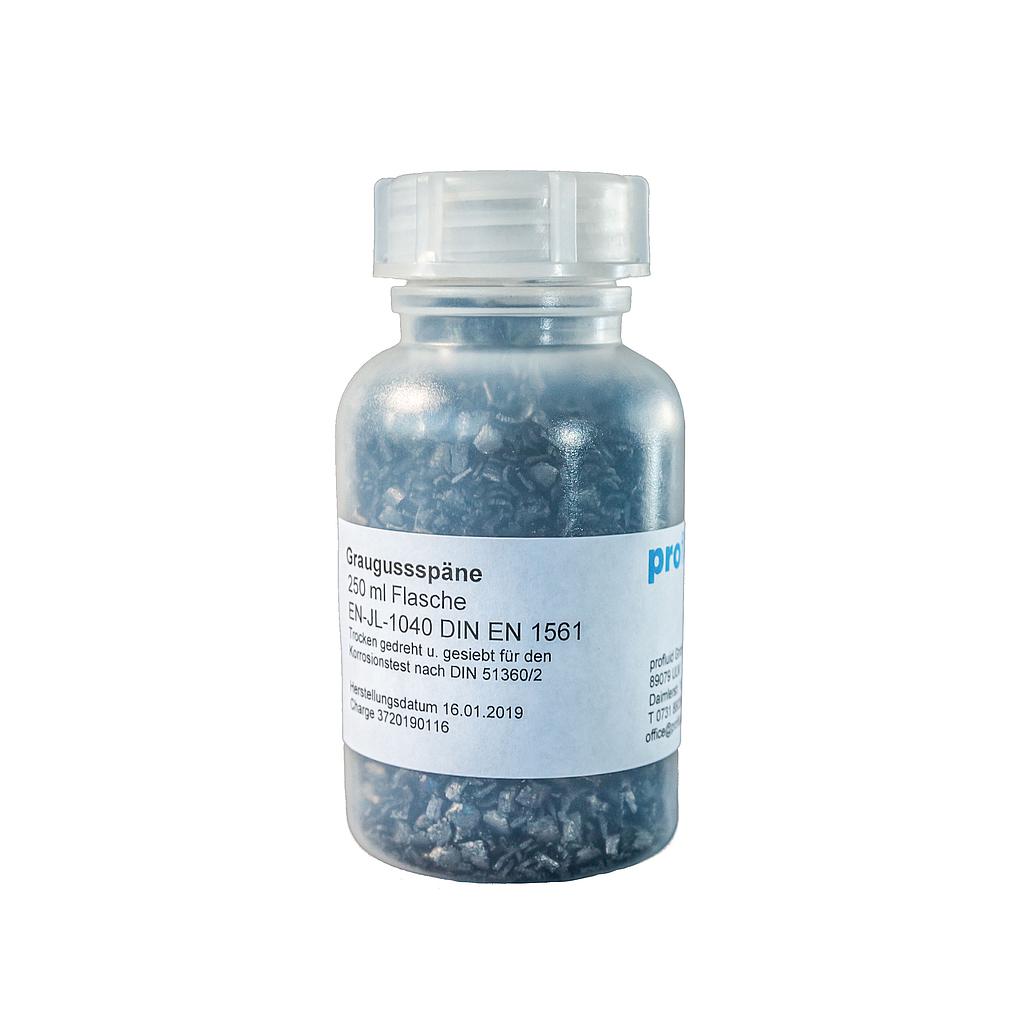Standard grey cast iron chips according to DIN 51360-2
for up to 300 corrosion protection tests
Corrosion during or after the machining fo steel or cast iron parts is often caused by unsuitable or already degraded water-mixed cooling lubricants and cleaners.
The cost of reworking or processing customer complaints is usually reworking or processing customer complaints is usually disproportionate to the price of the workpiece. Apart from this, their machines are also largely made of materials that are at risk of corrosion
Also suitable for the development of water-miscible KSS, media for corrosion protection
Our grey cast iron chips are dry milled from GG25 exactly according to the specifications of DIN51360-2 , sieved and dry packed.
The simplest corrosion protection test for the protection of iron or steel-based materials (products, tools, machines) in contact with water-mixed cooling lubricants, drilling emulsions, cleaners, cooling and quenching media.*
*Not suitable for testing acidic cleaners or pickling media. Please contact us directly if you have any questions:
offic@profluid.de. Wir können für Sie gerne einen Kompatibilitätstest durchführen.
Alternativ ohne Labor vor Ort durchführbar, in kürzerer Zeit und mit weniger Aufwand: Der fertig konfektionierte CorrSet.
Instruction corrosion protection tests according to DIN51360-2
Step 1:Draw a circle with a diameter of 40 mm on a filter paper with a diameter of 70 mm and place the filter paper in a Petri dish.
Step 2:
Weigh appr. 2g (0,070 0z.) of chips into a conical flask or reaction tube (25-35 chips) - don't touch the chips with bare hands.
Step 3:Use the pipette to apply cooling lubricant solution to the chips until they are thoroughly wetted.
Step 4:Tip wet chips into the petri dish. (The filter should be wet over the surface, but the chips should not be flooded with KSS - remove excess liquid if necessary. Hold the filter at a slight angle, use a pipette). Distribute the chips as evenly as possible.
Step 5:Start clock
Step 6:After 2 h, tilt the chips out of the petri dish, remove the wet filter with tweezers, rinse the filter briefly with water and allow to dry. (Alternatively, dip the wet filter briefly in acetone and allow to dry.) Evaluation: Compare the corrosion pattern with the template from the standard. Desired value is level 0 = no corrosion, 1 is still quite good, above that is actually not tolerable. (In the standard there is also a reading scheme). Classification is possible with an accuracy of 1 level)
Comment on the procedureThe test is a bit rough, but very useful if you can't explain why parts or machines rust or if you want to compare KSS. The standard differentiates between 4 degrees of corrosion according to the number and size of the spots, 0 means no corrosion 4 indicates serious defects in the corrosion protection. For a standard-compliant execution and evaluation, the standard should be obtained from Beuth-Verlag (https://www.beuth.de). The method can be used to check the condition of coolant lubricant on machines when processing steel and grey cast iron or to protect grey cast iron machine beds against corrosion in good time.
Reasons for a lack of corrosion protection in water-solube cooling lubricants:
Defective cooling lubricant recipe – manufacturer error
Use of too low concentrations
Degradation of the KSS by germs
….. many other reasons where we can help you
A typical question:
Comparison of the corrosion inhibition of 2 water miscible MWFs:
Use identical process water for the test - your own water! Concentration range: 2% 3% 4% 5% 6%. Wait until the solution is homogenous, that's essential.
At each concentration level:
Weigh 2g of shavings into a 50 ml Erlenmeyer.
Mark the Erlenmeyer with a felt pen e.g. A2%, A3%, A4% ...B2%, B3%, B4
Place one round filter in each petri dish. Label the covers in the same manner as the Erlenmeyer flasks. (2 samples are used for each concentration level in the standard norm.)
Other implementation see above.

